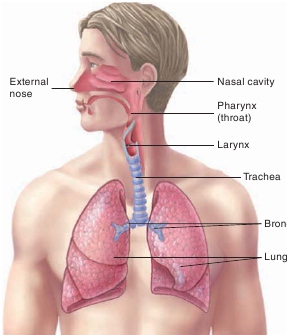CHAPTER 23 Respiratory System
823
23.1
Functions of the
Respiratory System
LEARNING OUTCOME
23.2
Anatomy and Histology of the
Respiratory System

After reading this section, you should be able to
A.
Describe the functions of the respiratory system.
After reading this section, you should be able to
A.
Describe the anatomy of the respiratory passages,beginning at the nose and ending with the alveoli.
B.
Describe the structural and functional anatomy of therespiratory system.
C.
State the parts of the respiratory membrane.
D.
Describe the structure of the lungs, including the bloodand lymphatic supply.
E.
Explain the roles of the thoracic wall and the pleura inrespiration.
F.
Explain how contraction of the muscles of respirationcauses changes in thoracic volume during quietbreathing and during labored breathing.
Breathing is critical for homeostasis. It provides our bodies withcrucial oxygen and expels carbon dioxide, a potentially toxic wasteproduct. Our respiratory system helps us breathe. Breathing is for-mally called
respiration.
For complete exchange of oxygen (O
2
)and carbon dioxide (CO
2
) in respiration, four steps occursimultaneously:
1.
Ventilation
. This is what most of us think of as breathing. It isthe movements of the thorax and certain muscles that causeair to go into and out of our lungs.2.
External respiration.
Oxygen enters the blood in the lungs andCO
2
exits the blood in the lungs.3.
Gas transport.
Carbon dioxide and O
2
are circulated in theblood to and from tissues.4.
Internal respiration.
Gas exchange with the tissues involves theexit of O
2
from blood to move into the tissues, while CO
2
exitsthe tissues to enter the blood.
It can be confusing to hear the term
respiration
alonebecause sometimes it also refers to cellular metabolism, or
cellular respiration
(discussed in chapter 25); in fact, the twoprocesses are related. Breathing provides the O
2
needed incellular respiration to make ATP from glucose. Breathing alsorids the body of potentially toxic CO
2
, the waste producedduring cellular respiration.In addition to respiration, the respiratory system performsthe following functions:
1.
Regulation of blood pH
. The respiratory system can alterblood pH by changing blood CO
2
levels.2.
Production of chemical mediators
. The lungs produce anenzyme called angiotensin-converting enzyme (ACE),which is an important component of blood pressure regula-tion (discussed in chapter 26).3.
Voice production
. Air moving past the vocal folds makessound and speech possible.4.
Olfaction
. The sensation of smell occurs when airbornemolecules are drawn into the nasal cavity (discussed inchapter 15).5.
Protection
. The respiratory system provides protectionagainst some microorganisms by preventing them fromentering the body and removing them from respiratorysurfaces.

ASSESS
YOUR PROGRESS
1.
What are the four steps of respiration?
2.
Explain the functions of the respiratory system.
There are seven structures that make up the respiratory system: theexternal nose, the nasal cavity, the pharynx (the throat), the larynx(the voicebox), the trachea (the windpipe), the bronchi (branchesof the trachea), and the lungs (figure 23.1). The diaphragm and themuscles of the thoracic and abdominal walls are responsible forrespiratory movements. (Although air frequently passes throughit, the oral cavity is considered part of the digestive system ratherthan the respiratory system.) The respiratory system can be

Lowerrespiratorytract
Upperrespiratorytract
Bronchi
Lungs
FIGURE 23.1
Respiratory System
The upper respiratory tract consists of the external nose, the nasal cavity,the pharynx (throat) and its associated structures, and the larynx. The lowerrespiratory tract consists of the trachea, the bronchi and smaller bronchi-oles, and the lungs.